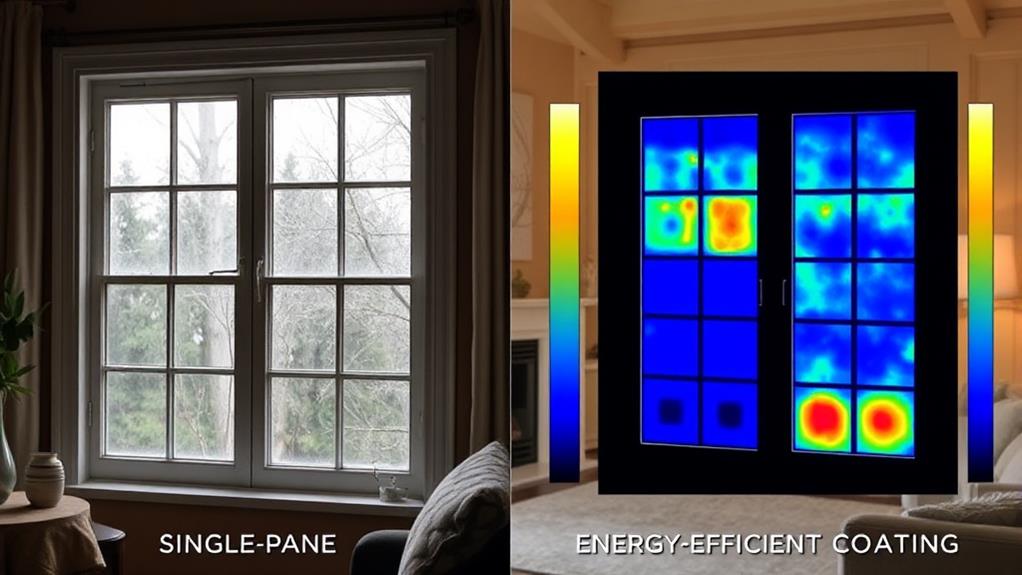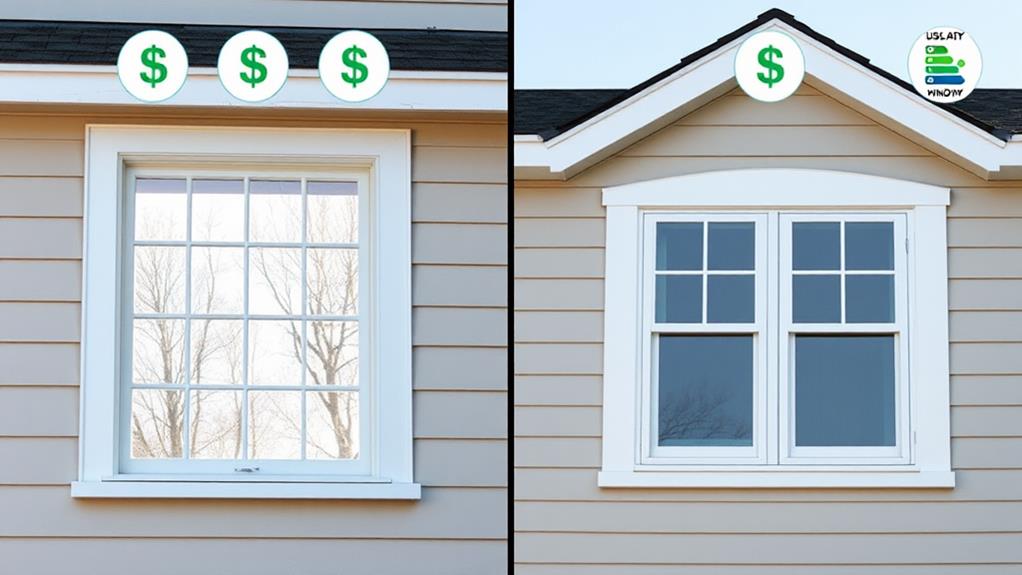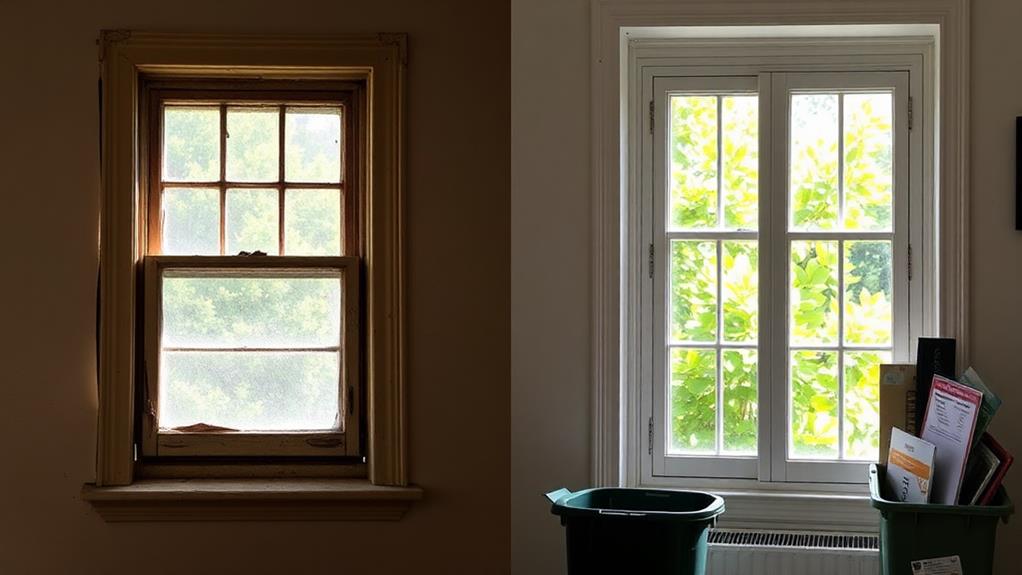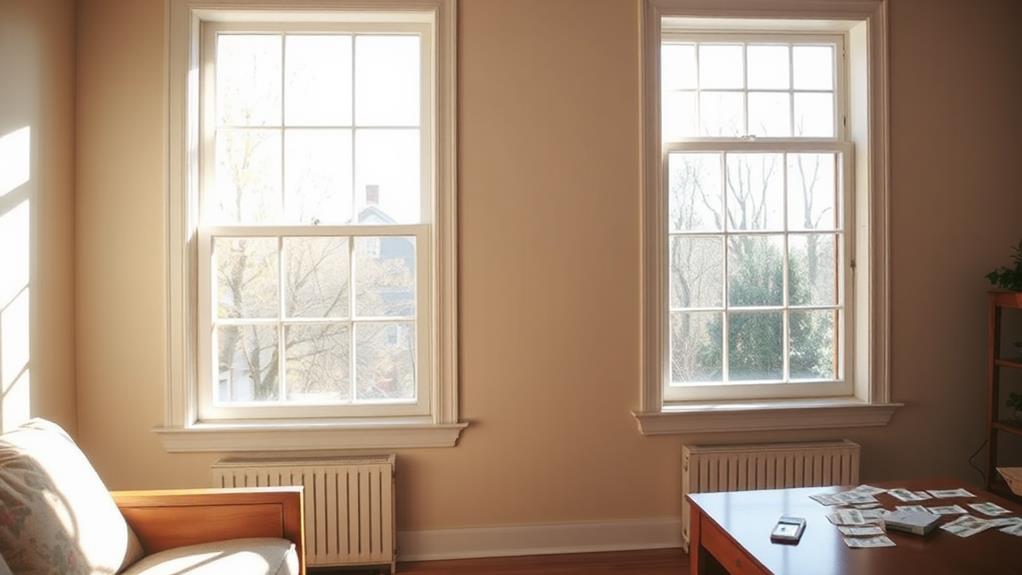When considering energy efficiency for your old windows, you'll need to choose between replacement and retrofitting. Replacing windows offers better long-term energy savings, increased home value, and improved aesthetics, but comes with higher upfront costs. Retrofitting is less expensive initially and conserves resources, but may not provide as significant energy savings. Your decision should factor in your budget, current window condition, and long-term goals. Replacement can reduce energy bills by 15-25%, while retrofitting yields 10-20% savings. To make the best choice for your home, you'll want to weigh all the factors carefully.
Understanding Window Energy Efficiency

Before diving into the debate of replacing versus retrofitting old windows, it's crucial to understand what makes a window energy efficient. Energy-efficient windows minimize heat transfer between your home's interior and the outside environment. They're designed to keep your home warm in winter and cool in summer, reducing your reliance on heating and cooling systems.
Key factors that contribute to a window's energy efficiency include:
- Glazing: Double or triple-pane glass filled with insulating gas like argon or krypton.
- Low-E coatings: Microscopic layers that reflect heat while allowing light to pass through.
- Frame material: Materials like vinyl, fiberglass, or wood offer better insulation than aluminum.
- Weather stripping: Seals gaps to prevent air leakage.
- Proper installation: Ensures the window performs as intended.
You can assess a window's energy efficiency by looking at its U-factor (rate of heat loss) and Solar Heat Gain Coefficient (SHGC). Lower U-factor values indicate better insulation, while lower SHGC values mean less solar heat gain. The National Fenestration Rating Council (NFRC) label provides standardized ratings to help you compare different windows' energy performance.
Assessing Your Current Windows
To determine whether you should replace or retrofit your existing windows, you'll need to assess their current condition and performance. Start by examining the window frames for signs of rot, warping, or damage. Check for drafts by holding a lit candle near the edges of closed windows; flickering flames indicate air leaks. Look for condensation between panes in double-glazed windows, which suggests seal failure.
Next, evaluate the window's overall functionality. Do they open and close smoothly? Are the locks secure? Consider the age of your windows; those over 20 years old are likely less energy-efficient than modern options. Assess the type of glass: single-pane windows are far less efficient than double or triple-pane variants.
Costs of Replacement vs. Retrofitting

After assessing your windows' condition, you'll need to weigh the costs of replacement versus retrofitting. Replacing windows is generally more expensive, with costs ranging from $300 to $1,000 per window, depending on size, material, and style. This includes labor for removal and installation.
However, replacement offers long-term energy savings and can increase your home's value.
Retrofitting, on the other hand, is typically cheaper, costing between $100 to $350 per window. Options include adding weatherstripping, caulking, or installing storm windows. While less expensive upfront, retrofitting may not provide as significant energy savings as replacement.
Consider your budget and long-term goals when deciding. If you're planning to stay in your home for many years, the higher initial cost of replacement might be justified by future energy savings. For a short-term solution or if you're on a tight budget, retrofitting could be more appropriate.
Don't forget to factor in potential energy rebates and tax incentives for energy-efficient upgrades. These can offset some of the costs associated with replacement windows, making them more financially viable.
Energy Savings Comparison
Energy savings form a crucial part of the decision between replacing and retrofitting windows. When comparing the two options, you'll find that both can significantly improve your home's energy efficiency, but to different degrees.
Replacing old windows with new, energy-efficient models typically offers the highest potential for energy savings. You can expect to reduce your energy bills by 15-25% with new windows, depending on the climate and the efficiency of your original windows. New windows provide better insulation, reduce air leakage, and often include low-E coatings and gas fills that further enhance their performance.
Retrofitting, on the other hand, can still yield substantial energy savings, usually in the range of 10-20%. Options like adding storm windows, weatherstripping, or applying window films can improve insulation and reduce drafts. While these measures may not match the energy savings of full replacement, they're often more cost-effective in the short term.
Your specific energy savings will depend on factors such as your local climate, the condition of your existing windows, and the quality of the replacement or retrofit solution you choose. Consider conducting an energy audit to determine the most effective approach for your home.
Environmental Impact Considerations

The environmental impact of your window choice extends beyond energy efficiency. When considering replacement versus retrofitting, you'll need to factor in the entire lifecycle of materials and processes involved.
Replacing windows requires new materials, which means more resource extraction and manufacturing. New windows often use vinyl or aluminum frames, both of which have significant environmental footprints. The production process consumes energy and may release harmful emissions. Additionally, you'll need to dispose of your old windows, potentially contributing to landfill waste.
On the other hand, retrofitting existing windows conserves resources by extending the life of your current frames. It typically involves adding weatherstripping, caulking, or installing storm windows. These methods use fewer new materials and generate less waste. However, the energy savings mightn't be as substantial as with new, high-efficiency windows.
You should also consider the longevity of each option. High-quality replacement windows can last decades, potentially offsetting their initial environmental impact through long-term energy savings. Retrofits may need more frequent maintenance or replacement, which could increase their environmental cost over time.
Ultimately, your decision should balance immediate environmental impact with long-term energy efficiency and durability.
Installation Process and Timeframes
Several factors influence the installation process and timeframes for both window replacement and retrofitting projects. When replacing windows, you'll need to account for the removal of old windows, which can take 30 minutes to an hour per window. The installation of new windows typically requires 1-2 hours each.
A full-house window replacement might take 2-3 days for an average home.
Retrofitting, on the other hand, is often quicker. Adding storm windows or applying window film can be done in a matter of hours for an entire house. Interior storm panels might take slightly longer, as they require custom fitting.
The complexity of your home's architecture, the number of windows, and their accessibility will affect the timeline. Second-story windows or those with unusual shapes may require more time and specialized equipment. Weather conditions can also impact the schedule, especially for exterior work.
You'll need to prepare the work area by removing window treatments and clearing space around each window. For replacements, expect some minor repairs to surrounding walls or trim. Retrofitting generally causes less disruption but may still require some prep work.
Long-Term Value and ROI

When considering window upgrades, you'll want to look beyond the initial costs and installation process to evaluate the long-term value and return on investment (ROI). Replacing old windows typically offers a higher ROI compared to retrofitting, as new windows provide better energy efficiency and can significantly reduce your heating and cooling costs. You'll see savings on your energy bills for years to come, often recouping your investment within 5-10 years.
New windows also increase your home's value, with potential buyers willing to pay more for a property with updated, energy-efficient windows. They'll appreciate the improved comfort, reduced noise, and enhanced curb appeal. Retrofitting, while less expensive upfront, may not provide the same level of energy savings or aesthetic improvements.
Consider the lifespan of your investment as well. New windows can last 20-30 years with proper maintenance, while retrofits may need to be replaced sooner. Factor in potential repairs and maintenance costs for both options when calculating long-term value. Ultimately, replacement windows often provide better ROI and long-term benefits, making them a wise choice for many homeowners.
Conclusion
As you weigh the window of opportunity before you, remember that both replacement and retrofitting can brighten your home's future. Like a breath of fresh air, improved energy efficiency will revitalize your living space and fatten your wallet. Whether you choose to turn over a new pane or give your current windows a makeover, you're taking a crystal-clear step towards a greener, more comfortable home. Don't let this chance slip through your fingers!

